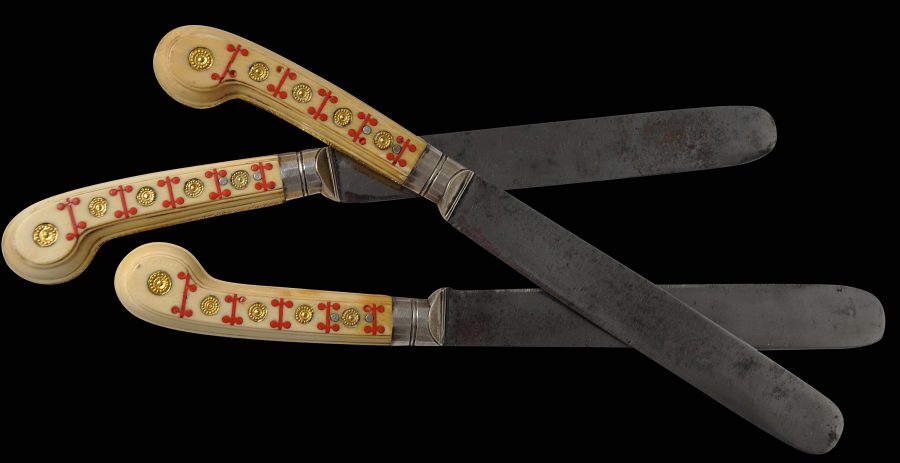These fine and rare knives are beautiful examples of Zanzibar and possibly Lamu craftsmanship from along the Swahili Coast, possibly by Omani craftsmen based in these areas. The blades are of polished steel and the handles are of ivory inset with solid gold plaques and strips, and bands of coral-red enamel. The gold and enamel inlay is to both sides of each handle. In addition, each handle is further embellished with a single strip of gold inlay that runs down the top, around the rounded end, and along the underside of each handle. All the gold plaques feature an impressed sun-burst motif, either singularly, or as a strip.
Ivory and gold work such as this is extremely rare. It is related to the ivory and gold work used on Omani-influenced sword hilts that were manufactured in Zanzibar in the eighteenth century. Examples of these swords are illustrated in Hales (2013, pp. 237-139). Also, click here to see a hair comb that shows similar ivory and gold work, now in the collection of the Minneapolis Institute of Art.
The three knives are in excellent condition; there are no repairs and no losses to the gold or enamel work.
Zanzibar comprises two larger islands and a series of smaller islands 25-50 kilometres off the coast of East Africa. Arab traders visited and traded with the islands for many centuries. In the 16th and 17th centuries, Zanzibar was under Portuguese control. And in 1698, it was sized by the Sultanate of Oman, and a ruling Arab elite with a local sultan was installed which developed the local economy further enhancing its trading links with the Middle East and with India.
Important trading communities of Muscat-descended Arabs and Indian Muslims established themselves in Zanzibar. The Indian Muslims comprised Ismailis – Khojas – and Bohoras particularly. Parsees from India also were another significant community. Another Muslim community, the Wahadimu, evolved too, by intermarriage between Africans and Arabs. Other groups included Ceylonese, Christian Goanese of Portuguese and Indian descent, and Indian Baluchis.
Zanzibar became renown as a source of ivory, spices and slaves. It also became a regional entrepot and was an important source of goods that were traded into Africa. The Sultan of Zanzibar also controlled parts of the East African coast which also facilitated this. By the mid-19th century, Zanzibar was the biggest slave centre in East Africa with around 50,000 slaves passing through its docks each year.
By the late 19th century, Zanzibar was under the control of the British. The islands gained independence from Britain in December 1963. A month later, the Republic of Zanzibar and Pemba was formed in a revolution that saw thousands of Arabs and Indians killed. The following April, the republic was subsumed into the mainland former colony of Tanganyika (later Tanzania). Zanzibar today has semi-autonomous status.
References
Dale, G., The Peoples of Zanzibar: Their Customs and Religious Beliefs, The Universities’ Mission to Central Africa, 1920.
Hales, R., Islamic and Oriental Arms and Armour: A Lifetime’s Passion, Robert Hale CI Ltd, 2013.






